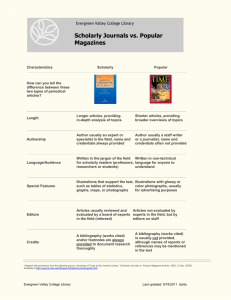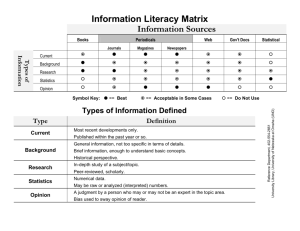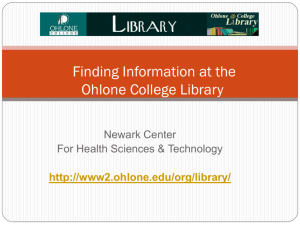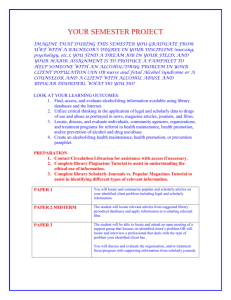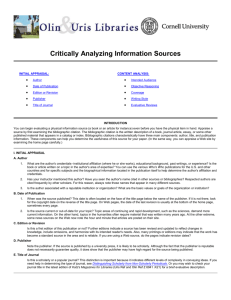Evaluating Sources
advertisement
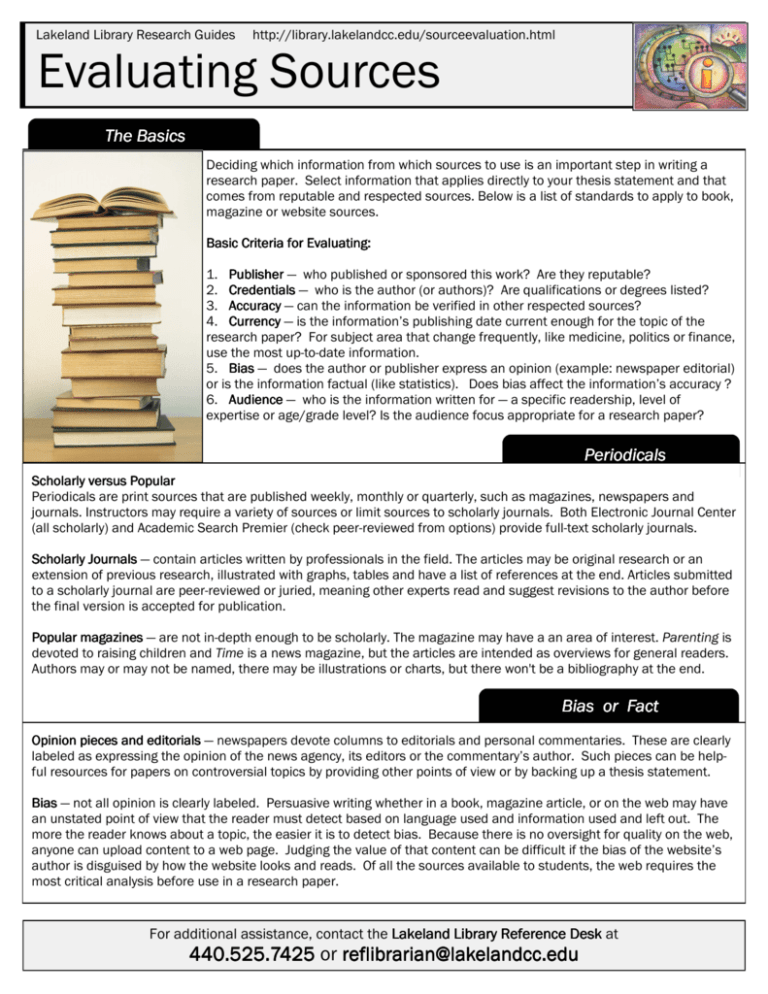
Lakeland Library Research Guides http://library.lakelandcc.edu/sourceevaluation.html Evaluating Sources The Basics Deciding which information from which sources to use is an important step in writing a research paper. Select information that applies directly to your thesis statement and that comes from reputable and respected sources. Below is a list of standards to apply to book, magazine or website sources. Basic Criteria for Evaluating: 1. Publisher — who published or sponsored this work? Are they reputable? 2. Credentials — who is the author (or authors)? Are qualifications or degrees listed? 3. Accuracy — can the information be verified in other respected sources? 4. Currency — is the information’s publishing date current enough for the topic of the research paper? For subject area that change frequently, like medicine, politics or finance, use the most up-to-date information. 5. Bias — does the author or publisher express an opinion (example: newspaper editorial) or is the information factual (like statistics). Does bias affect the information’s accuracy ? 6. Audience — who is the information written for — a specific readership, level of expertise or age/grade level? Is the audience focus appropriate for a research paper? Periodicals Scholarly versus Popular Periodicals are print sources that are published weekly, monthly or quarterly, such as magazines, newspapers and journals. Instructors may require a variety of sources or limit sources to scholarly journals. Both Electronic Journal Center (all scholarly) and Academic Search Premier (check peer-reviewed from options) provide full-text scholarly journals. Scholarly Journals — contain articles written by professionals in the field. The articles may be original research or an extension of previous research, illustrated with graphs, tables and have a list of references at the end. Articles submitted to a scholarly journal are peer-reviewed or juried, meaning other experts read and suggest revisions to the author before the final version is accepted for publication. Popular magazines — are not in-depth enough to be scholarly. The magazine may have a an area of interest. Parenting is devoted to raising children and Time is a news magazine, but the articles are intended as overviews for general readers. Authors may or may not be named, there may be illustrations or charts, but there won't be a bibliography at the end. Bias or Fact Opinion pieces and editorials — newspapers devote columns to editorials and personal commentaries. These are clearly labeled as expressing the opinion of the news agency, its editors or the commentary’s author. Such pieces can be helpful resources for papers on controversial topics by providing other points of view or by backing up a thesis statement. Bias — not all opinion is clearly labeled. Persuasive writing whether in a book, magazine article, or on the web may have an unstated point of view that the reader must detect based on language used and information used and left out. The more the reader knows about a topic, the easier it is to detect bias. Because there is no oversight for quality on the web, anyone can upload content to a web page. Judging the value of that content can be difficult if the bias of the website’s author is disguised by how the website looks and reads. Of all the sources available to students, the web requires the most critical analysis before use in a research paper. For additional assistance, contact the Lakeland Library Reference Desk at 440.525.7425 or reflibrarian@lakelandcc.edu Lakeland Library Research Guides http://library.lakelandcc.edu/sourceevaluation.html Evaluating Sources Detecting Bias Website Evaluation When deciding if a source is being objective about the information they are presenting, look for some of the following techniques used to convince readers that what they are reading is fact when it may not be: As mentioned, the web is self-published. Beyond the criteria mentioned for all resources look for additional proof of value in websites. Some hoax sites look very credible until viewed with a critical eye. Look for: 1. Persuasive (“loaded”) language — using words and sentences that solicit a positive or negative response from the reader or that lead the reader to the specific conclusion. 2. Misquoting a source— source this often happens in the news media when reporters reword, paraphrase or manipulate a statement or source’s information 3. Selective facts—taking information out of context or facts selective use of data—picking only information that supports the argument and leaving the rest out. 4. Distortion or stretching the facts—making issues more facts extreme by using misinformation or exaggeration. 5. Flawed research—basing a claim on too small a research sample, manipulating statistics, using “fuzzy science” or “bad math,” failing to report contrary conclusions from other scientists. 1. Mission/Vision/Purpose Statement—reveals Statement purpose of the website and point of view. 2. Credentials— Credentials a well-regarded sponsoring organization or an expert author. (Webpage content may not list an individual author.) 3. Date of last revision—this reveals how recently revision the content of a website has been reviewed. 4. Contact information— information is there a physical address and telephone number the researcher can use to contact a real person with questions? 5. Loaded language—words that assign emotional language value can be used to manipulate attitude. “Patriot” sounds better than “vigilante,” “insurgency” less scary than “civil war.” 6. Links—do other reputable websites link to the Links website and does it link to other reputable sites. Selected Web Resources General Sources Evaluating Sources from Berkley. Evaluating books, magazines and websites. http://www.lib.berkeley.edu/TeachingLib/Guides/ Evaluation.html Critically Analyzing Information Sources from Cornell. Step-by-step analysis of the source and content of information for research papers. http://www.library.cornell.edu/olinuris/ref/ research/skill26.htm Websites Evaluating Web Pages from Berkeley:: http://www.lib.berkeley.edu/TeachingLib/Guides/ Internet/Evaluate.html Five Criteria for Evaluating Web Pages from Cornell:: http://www.library.cornell.edu/olinuris/ref/ research/webcrit.html The Good, the Bad and the Ugly (Web Sources) from New Mexico State University: http://lib.nmsu.edu/instruction/evalcrit.html Lakeland Library Guides for research papers: Picking a Topic — Help finding the right topic http://library.lakelandcc.edu/topic.html Scholarly vs. Popular Periodicals — Chart and explanation of different types of periodicals http://library.lakelandcc.edu/jvsmag.html Subject Guides — Guides for specific subject areas http://library.lakelandcc.edu/findsources.html Web Search Tips – How to create good searches http://library.lakelandcc.edu/PDFs/research/ websearchtips.pdf Website Evaluation – How to evaluate websites http://library.lakelandcc.edu/sourceevaluation.html Writing and Citing — Citing in MLA http://library.lakelandcc.edu/writeandcite.html Order books, find and read articles, read full-text journals and e-books 24/7 at library.lakelandcc.edu

